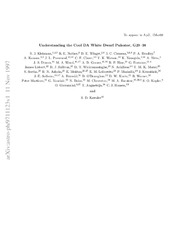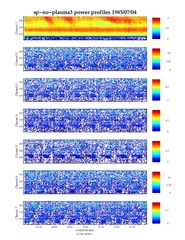Blar i utgivelsesdato Institutt for fysikk og teknologi
Viser treff 1-20 av 1260
-
Måling av plasmadrift i den øvre atmosfære over Ny-Ålesund, Svalbard.
(Master thesis; Mastergradsoppgave, 1977-11)Oppgaven bygger på målinger av plasmadrift i den øvre atmosfære over Ny-Ålesund, Svalbard. Som målemetode er brukt "spaced receivers" metoden. I kap. 2 er satt opp modeller for solvind, magnetosfære og ionosfære og en ser på fenomen som forplanter seg fra solvinden til ionosfæren. Ved hjelp av disse modeller beregnes så drift av plasma i ionosfæren. I kap. 3 beskrives målemetoden. Diffraksjonsmekanismen ... -
Observatoriet i 80-årene
(Journal article; Tidsskriftartikkel, 1980)På terskelen til en ny dekade er det naturlig å stille spørsmålet hva Observatoriets fremtidige rolle skal bli. Vil det fortsatt være behov for forskningsinnsats på Observatoriets tradisjonelle fagfelter, eller skal innsatsen etter hvert anta en annen retning? Vi skal forsøke å belyse dette ved først å rette blikket bakover for derigjennom å få øye på de store utviklingslinjer i den internasjonale ... -
Nordlys i verdensrommet
(Journal article; Tidsskriftartikkel, 1980)Vi vil ikke her gå inn i nordlyset som vi kjenner det fra jorden, men kort omtale andre steder i verdensrommet hvor vi har observert nordlyslignende fenomen eller hvor vi kan vente å finne beslektede fenomen. -
Nordlysobservatoriet i dag
(Journal article; Tidsskriftartikkel, 1980)Da Det Norske Institutt for Kosmisk Fysikk ble del av Universitetet i Tromsø, opphørte Nordlysobservatoriet å eksistere som en formell enhet. Det som i dag omfattes av Nordlysobservatoriet, er dels en fortsettelse av den opprinnelige observasjonsvirksomheten til det gamle Nordlysobservatoriet - men også nye aktiviteter har kommet til - særlig innen feltene plasmafysikk og radiogeofysikk. I det ... -
Fotoelektriske observasjonar av stjerneokkultasjonar ved måneranda
(Master thesis; Mastergradsoppgave, 1980-01)Analyser av okkultasjonskurvene frå fotoelektriske observasjonar viser at ein stor del av dei observerte stjernene er dobbelstjerner. Okkultasjonsteknikken kan lett åtskilje stjerner som har ein vinkelavstand større enn 0",01 og under gunstige tilhøve kan oppløysinga vere 0",001. I tillegg kan analysen av observasjonen gje vinkeldiameteren til stjerna dersom han er større enn 0",001. Utfrå ... -
Backpropagation Neural Networks for Facial Recognition
(Master thesis; Mastergradsoppgave, 1991-12)A survey was conducted testing the aptitude of neural networks to recognize human faces. The motivation for this a study is the possibility of designing automatic security systems. Pictures of 511 subjects were collected. The pictures captured both profiles and many natural expressions of the subject. Some of the subjects were wearing glasses, sunglasses or hats in some of the pictures. The images ... -
Enhancement of stratospheric aerosols after solar proton event.
(Journal article; Tidsskriftartikkel, 1996)The lidar measurements at Verhnetulomski observatory (68.6¡N, 31.8¡E) at Kola peninsula detected a considerable increase of stratospheric aerosol concentration after the solar proton event of GLE (ground level event) type on the 16/02/84. This increase was located at precisely the same altitude range where the energetic solar protons lost their energy in the atmosphere. The aerosol layer ... -
Understanding the Cool DA White Dwarf Pulsator, G29–38
(Journal article; Tidsskriftartikkel; Peer reviewed, 1997-10-10)The white dwarfs are promising laboratories for the study of cosmochronology and stellar evolution. Through observations of the pulsating white dwarfs, we can measure their internal structures and compositions, critical to understanding post main sequence evolution, along with their cooling rates, allowing us to calibrate their ages directly. The most important set of white dwarf variables to ... -
Superposed epoch analysis applied to large-amplitude travelling convection vortices.
(Journal article; Tidsskriftartikkel, 1998)For the six months from 1 October 1993 to 1 April 1994 the recordings of the IMAGE magnetometer network have been surveyed in a search for large- amplitude travelling convection vortices (TCVs). The restriction to large amplitudes (>100 nT) was chosen to ensure a proper detection of evens also during times of high activity. Readings of all stations of the northern half of the IMAGE network ... -
Observations of thermospheric neutral winds within the polar cusp and the auroral oval using a Doppler imaging system (DIS).
(Journal article; Tidsskriftartikkel, 1998)Two Doppler imaging systems (DIS) or wide-field imaging Fabry-Perot interferometers (FPI), have recently been commissioned, one at the Auroral Station, Adventdalen, Longyearbyen, Svalbard, and the second at the IRF, Kiruna, Sweden. These instruments can provide wide-field (600 * 800 km) images of neutral wind flows in the upper thermosphere, by measuring the Doppler shift of the atomic oxygen forbidden ... -
Spectral characteristics of spring arctic mesosphere dynamics.
(Journal article; Tidsskriftartikkel, 1998)The spring of 1997 has represented a stable period of operation for the joint University of Tromsù / University of Saskatchewan MF radar, being between refurbishment and upgrades. We examine the horizontal winds from the February to June inclusive and also include estimates of energy dissipation rates derived from signal fading times and presented as upper limits on the turbulent energy ... -
Observations of auroral plasma lines
(Master thesis; Mastergradsoppgave, 1998-03-01)The thesis describes observations of strongly enhanced incoherent scatter plasma lines in the auroral ionosphere which were made with the EISCAT UHF radar in 1985. The linear theory of plasma instabilities is reviewed, and several possible explanations are discussed. The observations were found to be of insufficient resolution to unambiguously resolve which one would be the correct explanation. ... -
Three photometric methods tested on ground-based data of Q 2237+0305
(Journal article; Tidsskriftartikkel; Peer reviewed, 1998-09-09)The Einstein Cross, Q 2237+0305, has been photometrically observed in four bands on two successive nights at NOT (La Palma, Spain) in October 1995. Three independent algorithms have been used to analyse the data: an automatic image decomposition technique, a CLEAN algorithm and the new MCS deconvolution code. The photometric and astrometric results obtained with the three methods are presented. ... -
Electron velocity distribution function in a plasma with temperature gradient and in the presence of suprathermal electrons: application to incoherent-scatter plasma lines.
(Journal article; Tidsskriftartikkel, 1998-10-31)The plasma dispersion function and the reduced velocity distribution function are calculated numerically for any arbitrary velocity distribution function with cylindrical symmetry along the magnetic field. The electron velocity distribution is separated into two distributions representing the distribution of the ambient electrons and the suprathermal electrons. The velocity distribution function of ... -
Effect of suprathermal electrons on the intensity and Doppler frequency of electron plasma lines.
(Journal article; Tidsskriftartikkel, 1999)In an incoherent scattering radar experiment, the spectral measurement of the so-called up- and downshifted electron plasma lines provides information about their intensity and their Doppler frequency. These two spectral lines correspond, in the backscatter geom- etry, to two Langmuir waves travelling towards and away from the radar. In the daytime ionosphere, the presence of a small percentage ... -
MIDAS-W: a workstation-based incoherent scatter radar data aquisition system.
(Journal article; Tidsskriftartikkel, 2000)The Millstone Hill Incoherent Scatter Data Acquisition System (MIDAS) is based on an abstract model of an incoherent scatter radar. This model is implemented in a hierarchical software system, which serves to isolate hardware and low-level software implementation details from higher levels of the system. Inherent in this is the idea that implementation details can easily be changed in response to ... -
Irregular structures of the F layer at high latitudes during ionospheric heating.
(Journal article; Peer reviewed; Tidsskriftartikkel, 2000)Results on heating the ionospheric F region above Tromsø, Norway are presented. The ionosphere was monitored by satellite tomography and amplitude scintillation methods as well as the EISCAT incoherent scatter radar. No effect of heating was observed in the daytime. In the evening and in the pre-midnight sector, noticeable tilts of the F region were observed during heating periods. The tilts overlapped ... -
Comparison of the orientation of small-scale electron density irregularities and F region plasma flow direction.
(Journal article; Tidsskriftartikkel; Peer reviewed, 2000)Results are shown from an experimental campaign where satellite scintillation was observed at three sites at high latitudes and, simultaneously, the F region plasma flow was measured by the nearby EISCAT incoherent scatter radar. The anisotropy parameters of field-aligned irregularities are determined from amplitude scintillation using a method based on the variance of the relative logarithmic ... -
Plasma density over Svalbard during the ISBJØRN campaign.
(Journal article; Peer reviewed; Tidsskriftartikkel, 2000)In 1997, reliable operation of the EISCAT Svalbard Radar (ESR) was achieved and a rocket launching facility at Ny Ålesund on Svalbard (79°N, 12°E) (SVALRAK) was established. On 20 November, 1977, the first instrumented payload was launched from SVALRAK. Although the payload configuration had been flown many times previously from Andøya Rocket Range on the Norwegian mainland, this presented an ... -
Geomagnetic control of polar mesosphere summer echoes.
(Journal article; Tidsskriftartikkel, 2000)Using observations with the ALOMAR SOUSY radar near Andenes (69.3°N, 16.0°E) from 1994 until 1997 polar mesosphere summer echoes (PMSE) have been investigated in dependence on geomagnetic K indices derived at the Auroral Observa- tory Tromsù (69.66°N, 18.94°E). During night-time and morning hours a significant correlation between the signal-to-noise ratio (SNR) of the radar results and ...


 English
English norsk
norsk


















